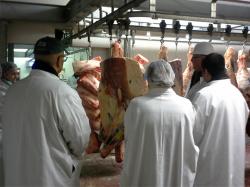Culinary Students Get Farm-To-Table View Of Beef Process
March 27, 2014 | 2 min to read

The beef checkoff, through its Northeast Beef Promotion Initiative (NEBPI), facilitated a culinary school tour of Old Line Custom Meats Company in Baltimore, Md. on March 15. A culinary purchasing class from Howard Community College (HCC) of Columbia, Md., spent the morning exploring an unfamiliar aspect of the cattle industry: beef processing.
Old Line Meats is a USDA-inspected fresh meat fabricator that sells wholesale meats to restaurants, butcher shops, grocery stores and institutions. Old Line Meats dry ages and custom cuts to customer specifications. They process domestic lamb, veal, beef and feature Roseda Black Angus Beef as a private label item.
Chef instructor Jana Anderson with HCC said she realizes the benefits her students receive from being exposed to broader educational experiences related to the beef industry. “With the whole 'Farm to Table' movement that is going on in the restaurant industry right now, it has never been so important for chefs to take great interest in where the products that they serve originate," Anderson said. "As culinary students enter the industry, it is important for them to understand not only how to ‘order’ meat products, but to be able to distinguish between the different kinds, in order to provide the best possible products for their guests.
"A lot of the students were quite shocked by the carcasses that they saw hanging in the plant, because most have never seen any meat in a form other than in a package that they see in a grocery store," Anderson added. "All of them agreed that seeing where the different types of meat comes from on the animal helped them better understand why different cuts of beef have different textures. They also said that, after seeing the meat as part of an animal, they became more interested in trying to learn how to work with different cuts of beef and use the majority of the meat from the carcass.”
Mike Brannon, vice president of Old Line Custom Meat Company, was pleased with the results of the tour. “In touring Old Line Meats, culinary students gained a better understanding of where their food comes from and what is involved in the journey from farm to fork," he said. "Most culinary students have never seen beef on the rail. The tour gives them the opportunity to visualize where the different cuts come from and how the placement in the carcass impacts the best use and culinary approach in the preparation of the cuts. This better enables them in their future careers in the culinary field.”
For more information about your beef checkoff investment, visit MyBeefCheckoff.com.
The Beef Checkoff Program was established as part of the 1985 Farm Bill. The checkoff assesses $1 per head on the sale of live domestic and imported cattle, in addition to a comparable assessment on imported beef and beef products. States retain up to 50 cents on the dollar and forward the other 50 cents per head to the Cattlemen's Beef Promotion and Research Board, which administers the national checkoff program, subject to USDA approval.
Source: The Beef Checkoff Program
